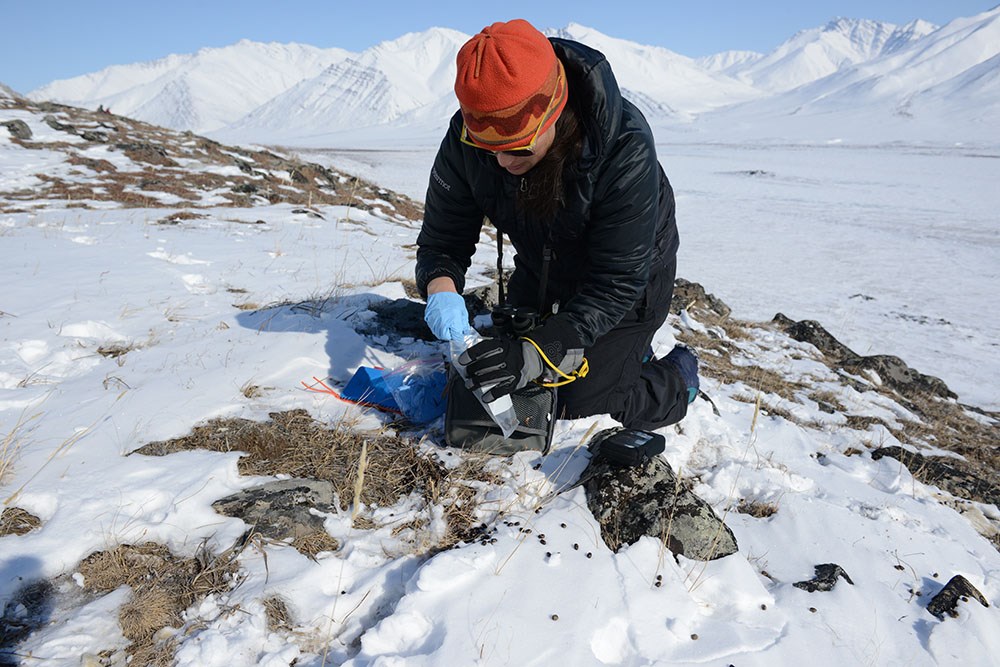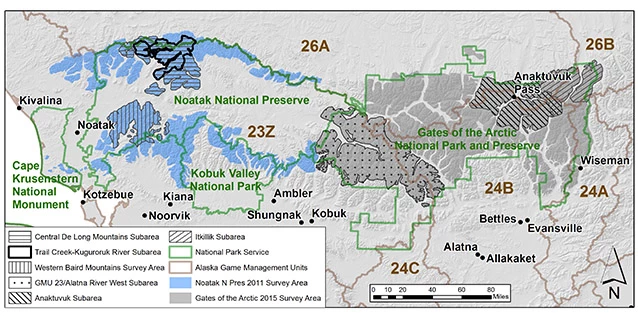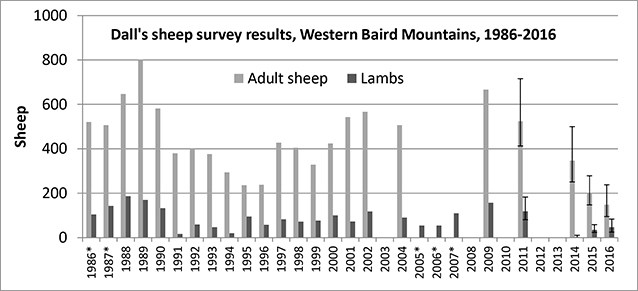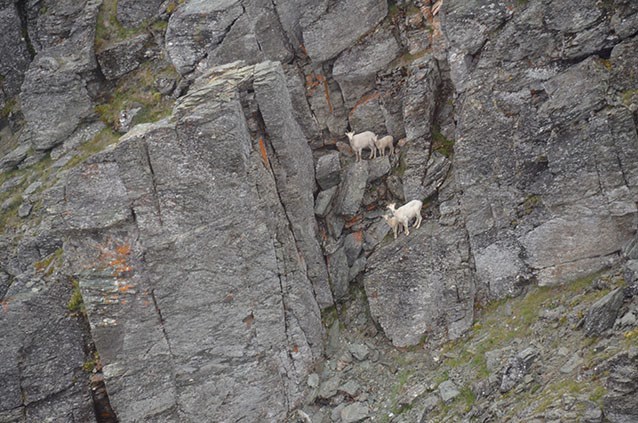Part of a series of articles titled Alaska Park Science - Volume 16 Issue: Science in Alaska's Arctic Parks.
Article
Declining Sheep Populations in Alaska’s Arctic Parks
By Kumi Rattenbury and Joshua Schmidt, National Park Service
Dall’s sheep (Ovis dalli) populations may be at an all-time low in Noatak National Preserve and Gates of the Arctic National Park and Preserve since the first park-wide surveys were conducted in the early 1980s. These parks were estimated to have ~12,000 sheep (~9,800 adult sheep) in 2010-2011, but severe winter weather in 2013 and 2014 (among other factors) reduced populations by 50-80% in some areas.
In particular, lamb numbers were very low in 2013 in multiple mountain ranges in Alaska and Canada following a colder-than-normal winter and record-cold temperatures in May when lambs are born. Whether there were fewer lambs born that year or they did not survive the cold spring, very few were seen in July when most surveys are conducted. Although sheep populations throughout Alaska were impacted, the recent decline appeared to be more pronounced in the north. In Noatak and Gates of the Arctic, the decline affected all age classes and lamb recruitment has been low from 2012-2015.
Dall’s sheep (Ovis dalli) populations may be at an all-time low in Noatak National Preserve and Gates of the Arctic National Park and Preserve since the first park-wide surveys were conducted in the early 1980s. These parks were estimated to have ~12,000 sheep (~9,800 adult sheep) in 2010-2011, but severe winter weather in 2013 and 2014 (among other factors) reduced populations by 50-80% in some areas.
In particular, lamb numbers were very low in 2013 in multiple mountain ranges in Alaska and Canada following a colder-than-normal winter and record-cold temperatures in May when lambs are born. Whether there were fewer lambs born that year or they did not survive the cold spring, very few were seen in July when most surveys are conducted. Although sheep populations throughout Alaska were impacted, the recent decline appeared to be more pronounced in the north. In Noatak and Gates of the Arctic, the decline affected all age classes and lamb recruitment has been low from 2012-2015.

NPS Photo / Stacia Backensto
We surveyed Noatak and adjacent habitat in 2011 and again in 2014 with the Alaska Department of Fish and Game, including two subareas in the western Baird Mountains and central De Long Mountains, which we surveyed again in 2015 (Bairds only) and 2016 (Figure 1). We estimated there were 784 adult sheep (583-1,080 at 95% Bayesian credible intervals [CI]) in Noatak in 2014, down 65% since 2011. The 2015 and 2016 surveys indicated continued decline of all age classes, with 67% fewer adult sheep in the western Baird Mountains in 2016 compared with the average of 20 surveys from 1988 to 2015 (Figure 2; Shults 2004). In the Trail Creek-Kugururok River portion of the central De Long Mountains, the 2016 estimates were similar to numbers observed during a previous crash in the 1990s (Dau 2002).


Surveys were also conducted across Gates of the Arctic and adjacent habitat in 2009, 2010, and 2015, in the Itkillik subarea annually from 2009-2016, and in the Anaktuvuk subarea in 2009, 2010, and 2014-2016 (Figure 1). We estimated there were 5,526 adult sheep (4,910-6,244 at 95% CI) in Gates of the Arctic in 2015, down 25% since 2010, but the decline was more obvious in the north (over 50% fewer sheep in the Itkillik and Anaktuvuk subareas) compared with more stable numbers in the southwestern portion of the park (Game Management Unit [GMU] 23/Alatna River West subarea). Although the ratio of lambs to ewes was higher in 2015 than in 2013 and 2014, the 2016 survey results indicate recruitment of those lambs was not substantial in the Itkillik and Anaktuvuk subareas. Recovery of sheep populations in Gates of the Arctic and Noatak will be slowed by the multi-year lag in lamb recruitment.
Dall’s sheep are an important subsistence species for local residents, particularly when caribou are scarce, and they are highly valued by sport hunters and wildlife enthusiasts. Noatak has been closed to sheep hunting since 2014 due to the decline, but closures are not new to the region. In 1991, when adult sheep dropped 50% in the western Baird Mountains following two high-snowfall winters, state and federal hunts were closed across Noatak for several years then reopened under limited quotas (Shults 2004). The population returned to pre-1991 levels by 2009 following milder winters, but has been in decline since (Figure 2). Federal hunting regulations have become more restrictive in southern Gates of the Arctic due to the decline, and park staff have been encouraging communities to curb ewe harvest while populations are low.
Populations fluctuate naturally as Dall’s sheep are an alpine-adapted and relatively non-migratory species sensitive to environmental change. Multiple factors can affect population dynamics including stochastic weather events, long-term environmental change, nutrition, predation, hunting, development, parasites, and disease. Large-scale declines have been primarily linked to severe winter weather such as deep snow, extreme cold, and icing events, which may reduce access to forage and increase vulnerability to predation (Nichols and Bunnell 1999). Increases in winter weather variability or changes in vegetation phenology or species composition related to climate change may impact sheep populations, particularly in Noatak where the small populations in the Baird and De Long Mountains exist at the northwestern edge of the species range and are relatively isolated from one another and the larger population in Gates of the Arctic.

NPS Photo /Marci Johnson
References
Dau, J. 2002.
Units 23 and 26A. Dall sheep management report. Pages 142-154 in C. Healy, editor. Dall sheep management report of survey and inventory activities 1 July 1998-30 June 2001. Alaska Department Fish and Game. Proj. 6.0. Juneau, Alaska.
Nichols, L. and F. L. Bunnell. 1999.
Natural history of thinhorn sheep. In R. Valdez and P. R. Krausman, eds. Mountain sheep of North America. pp. 23-77. The University of Arizona Press, Tucson.
Schmidt, J. H., K. L. Rattenbury, J. P. Lawler, and M. C. MacCluskie. 2012.
Using distance sampling and hierarchical models to improve estimates of Dall’s sheep abundance. Journal of Wildlife Management 76:317-327.
Schmidt, J. H. and K. L. Rattenbury. 2013.
Reducing effort while improving inference: Estimating Dall’s sheep abundance and composition in small areas. Journal of Wildlife Management 77:1048-1058.
Shults, B. 2004.
Abundance survey of Dall’s sheep in the western Baird Mountains, Alaska, July 2004. Technical Report NPS/AR/NRTR-2004-46. U.S. Department of the Interior, National Park Service. Anchorage, Alaska.
Last updated: November 1, 2022
